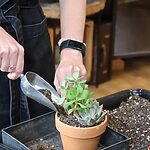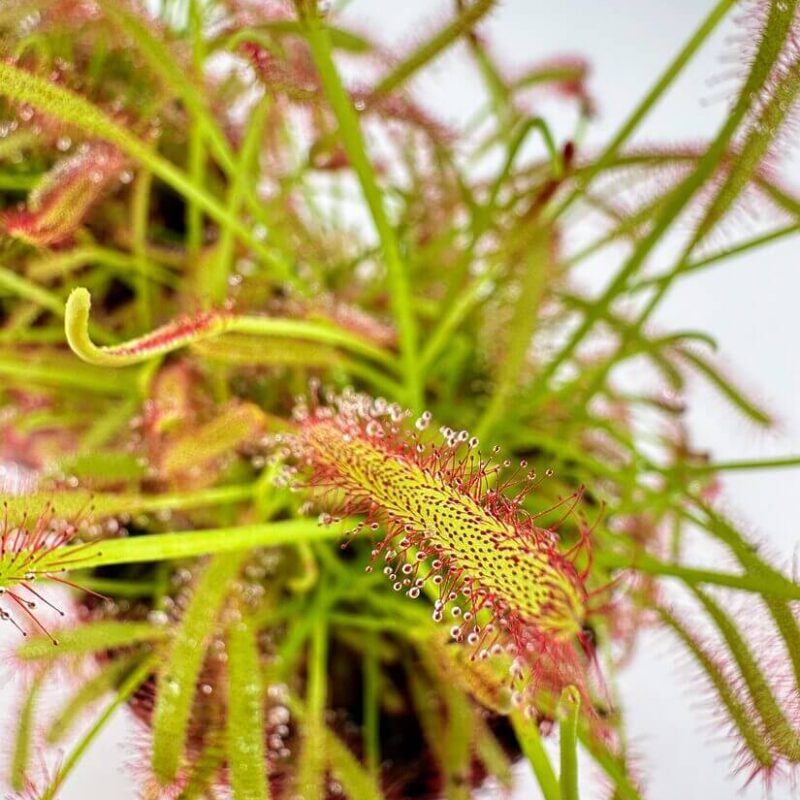Carnivorous Sundew Drosera Capensis
Carnivorous Sundew Drosera Capensis – A Powerful Fungus Gnat Killer
The Carnivorous Sundew Drosera Capensis is a mesmerizing and highly effective fungus gnat killer, known for its sticky, tentacle-like leaves that effortlessly trap and digest insects. This fascinating carnivorous plant secretes a glistening, sticky substance that lures in gnats, flies, and other pests, naturally keeping your indoor plants pest-free. With its striking red-tipped leaves and unique curling motion, this is a must-have for any carnivorous plant collector or enthusiast.
Why Choose the Sundew Drosera Capensis?
✔ Fungus Gnat Killer – A natural, eco-friendly way to control pests.
✔ Fast-Growing & Easy Care – Ideal for beginners and experienced growers alike.
✔ Beautiful & Unique – Features sticky, red-tipped leaves that curl around trapped insects.
✔ Self-Sufficient Carnivore – Requires no fertiliser, thriving on insects alone.
How to Care for Your Sundew Drosera Capensis
- Light: Prefers bright, indirect light or at least 4-6 hours of direct sunlight daily.
- Water: Use only distilled or rainwater—tap water contains minerals that can harm the plant. Keep the soil consistently moist.
- Humidity: Thrives in moderate to high humidity, making it perfect for terrariums.
- Feeding: Catches gnats, flies, and other insects naturally—no need for additional feeding.
- Dormancy: Unlike some carnivorous plants, this species does not require dormancy and can grow year-round.
🪴 Please note: The pictures shown are examples of our stock. Each Carnivorous Sundew Drosera Capensis is unique, with natural variations in size and colour. However, all are healthy and carefully selected. Every plant purchase includes a beautifully illustrated care guide to help you keep your Sundew thriving.
Why Buy from Us?
We take pride in offering high-quality Carnivorous Sundew Drosera Capensis plants, carefully grown and shipped in excellent condition.
Order yours today and enjoy a natural fungus gnat killer while adding a stunning carnivorous plant to your collection!
Click here to check our care instructions to find out how to look after your carnivorous plant.
Would you like to learn about carnivorous plants? Check our article here.
Pet Friendly
- What type of water should I use for my Carnivorous Sundew, and how often should it be watered?
- Always use distilled or rainwater, as tap water can contain minerals harmful to the plant. Keep the soil consistently moist but not waterlogged.
- Can the Carnivorous Sundew Drosera Capensis be grown in a terrarium environment?
- Yes, it thrives in moderate to high humidity environments, making it an excellent choice for terrariums where such conditions are easier to maintain.
- Is the Carnivorous Sundew suitable for beginners?
- Absolutely, it is fast-growing and requires minimal care other than correct watering and light. It also does not need fertiliser, making it ideal for those new to carnivorous plants.
☀️ Light
☀️☀️☀️ (High) – The Sundew Drosera Capensis thrives in bright, indirect light or at least 4-6 hours of direct sunlight daily. Ensure it gets ample light to keep its leaves vibrant and sticky for catching those pesky gnats!
💧 Water
💧💧💧 (High) – It’s essential to keep the soil consistently moist. Remember to use only distilled or rainwater, as tap water can contain minerals that harm the plant.
💧️ Temperature
🌡️️🌡️️▫️ (Average) – This plant prefers typical indoor temperatures but will tolerate a range. Keep it away from draughts and sudden temperature changes to maintain its health.
💦 Humidity
💦💦💦 (High) – Sundew Drosera Capensis loves a humid environment, making it perfect for terrariums or a well-humidified room.
🪴 Repotting
Repotting is rarely needed. If you must, use a potting mix suitable for carnivorous plants, ensuring good drainage and aeration. The best time to repot is during the spring.
🐾 Pet Friendliness
This plant is pet-friendly! No worries about curious paws or noses causing harm.
🪴 Recommended Locations at Home
Place your Sundew in well-lit kitchens, sunrooms, or near east or south-facing windows. Just make sure it’s out of direct harsh sunlight during the peak afternoon hours.
✨ Other Plant Features
Aside from being a natural pest controller, the Sundew is a fascinating plant to watch. The leaves curl around their prey, and its red-tipped tentacles add a dash of colour to any room.
If you have any more questions or need further assistance, remember you can always ask Mossbot or contact us via our website. We also offer a free plant hospital service if your Sundew needs extra care!

Free Care Guide With Every Purchase
Scan the plant pot QR for instant access to our care guide for your plant. No hassle, no stress, just healthy and happy plants.
8 reviews for Carnivorous Sundew Drosera Capensis
| 5 star | 100% | |
| 4 star | 0% | |
| 3 star | 0% | |
| 2 star | 0% | |
| 1 star | 0% |
Customer Images

 Carnivorous Sundew Drosera Capensis
Carnivorous Sundew Drosera Capensis
























Beautiful plant – healthy
Very happy with purchase. Plant is feeding well.
Very happy with my new sundew with its very attractive red fringes. I’ve added it with my previous two into an carnivorous plant pot, topped with sphagnum. It’s doing a great job on the fungus gnats!
first time have this plant